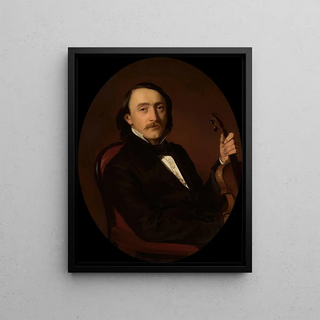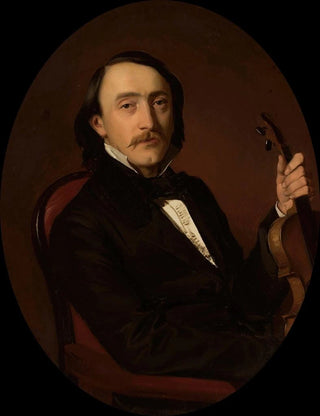Art print | Portrait of Nikodem Biernacki - Józef Simmler


View from behind

Frame (optional)
Nikodem Biernacki Portrait - Józef Simmler – Engaging Introduction
The "Nikodem Biernacki Portrait" by Józef Simmler is a work that transcends the simple frame of painting to establish itself as a true testament to the era and the personality of its subject. By capturing the very essence of Nikodem Biernacki, this art print evokes a psychological depth that invites the viewer to delve into the intimate universe of its model. Simmler, with undeniable mastery of light and shadow, manages to bring this representation to life, offering a window into Biernacki's soul. This art print is not merely a simple image; it tells a story, that of a man, but also that of a period marked by artistic and social upheavals.
Style and uniqueness of the work
The uniqueness of this art print lies in the way Simmler manages to combine realism and expressionism. The features of Nikodem Biernacki's face are rendered with striking precision, each detail carefully crafted to reflect not only the physical appearance but also the mindset of the model. The colors, subtly chosen, create an atmosphere that oscillates between melancholy and contemplation. Simmler uses chiaroscuro technique to emphasize the contrast between light and shadow, which gives the portrait an almost sculptural dimension. This style, both classic and innovative, demonstrates the artist's skill in capturing complex emotions while respecting the conventions of his time.
The artist and his influence
Józef Simmler, an emblematic figure of 19th-century Polish painting, knew how to mark his era with his unique approach to portraiture. Influenced by the great masters of the Renaissance and Baroque, he integrated elements of these styles into his own creations, while developing a personal sensitivity. Simmler was not merely a painter but also a keen observer of the society around him. His works, including the "Nikodem Biernacki Portrait," reveal a deep respect for individuality and human complexity. By exploring themes such as identity and memory, he

Matte finish

View from behind

Frame (optional)
Nikodem Biernacki Portrait - Józef Simmler – Engaging Introduction
The "Nikodem Biernacki Portrait" by Józef Simmler is a work that transcends the simple frame of painting to establish itself as a true testament to the era and the personality of its subject. By capturing the very essence of Nikodem Biernacki, this art print evokes a psychological depth that invites the viewer to delve into the intimate universe of its model. Simmler, with undeniable mastery of light and shadow, manages to bring this representation to life, offering a window into Biernacki's soul. This art print is not merely a simple image; it tells a story, that of a man, but also that of a period marked by artistic and social upheavals.
Style and uniqueness of the work
The uniqueness of this art print lies in the way Simmler manages to combine realism and expressionism. The features of Nikodem Biernacki's face are rendered with striking precision, each detail carefully crafted to reflect not only the physical appearance but also the mindset of the model. The colors, subtly chosen, create an atmosphere that oscillates between melancholy and contemplation. Simmler uses chiaroscuro technique to emphasize the contrast between light and shadow, which gives the portrait an almost sculptural dimension. This style, both classic and innovative, demonstrates the artist's skill in capturing complex emotions while respecting the conventions of his time.
The artist and his influence
Józef Simmler, an emblematic figure of 19th-century Polish painting, knew how to mark his era with his unique approach to portraiture. Influenced by the great masters of the Renaissance and Baroque, he integrated elements of these styles into his own creations, while developing a personal sensitivity. Simmler was not merely a painter but also a keen observer of the society around him. His works, including the "Nikodem Biernacki Portrait," reveal a deep respect for individuality and human complexity. By exploring themes such as identity and memory, he






